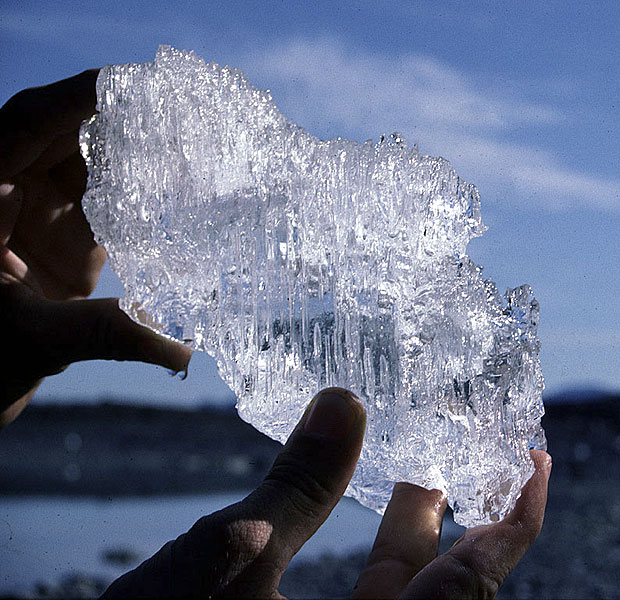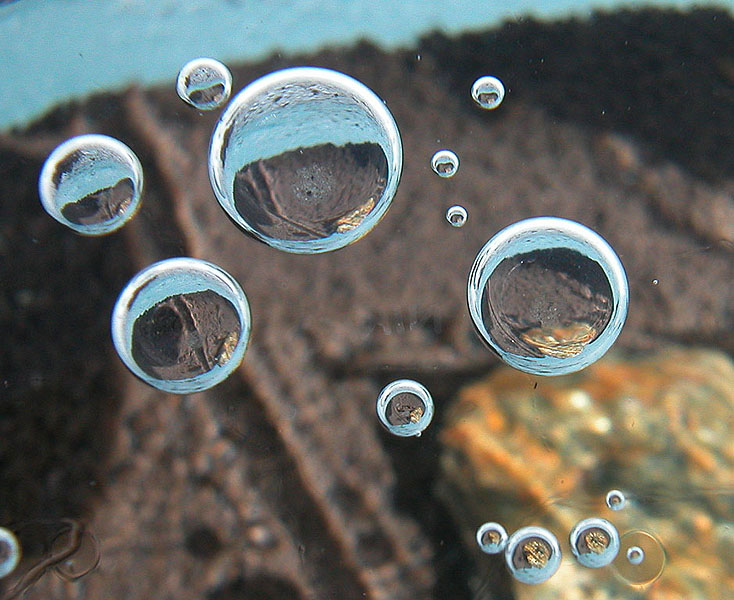Birth, growth and decay of glaciersGlaciers grow principally from the accumulation of snow and coversion to ice, and decay through melting of ice in their lower reaches. This group of photographs illustrates some of the processes associated with accumulation and ablation, the balance between which controls the health of a glacier. |
 High elevations in the tropical Andes receive large quantities of snow during the rainy season in summer. This peak of Nevado Parón (5600 m) bears the characteristic mushroom-like growths of snow and ice, as well as ice cliffs that feed into the glacier below. MH |  The transformation of snow to ice results in interlocking crystals and entrapment of bubbles, as seen in this thin section of ice from the north Norwegian glacier; Charles Rabots Bre. The photograph was taken through crossed polaroid plates which brings out the crystal structure. The straight lines represent a centimetre grid. MH |  In slow moving or stagnant temperate glaciers, ice crystals can attain large sizes, as this example from Columbia Glacier, Alaska demonstrates. MH |  Climbers ascending Weissmies (4023 m) in the Swiss Alps are dwarfed by the crevasse they have just crossed. The crevasse wall clearly shows the accumulation layering, the most prominent of which bound a year’s accumulation of snow. The yellowish layers mark deposits of Saharan dust which is commonly transported by wind over central Europe. JA |
 Snow accumulation layers in a glacier cliff bordering Granite Harbour, western Ross Sea, Antarctica. The base of the basin-like form defines a break in deposition and is referred to as an unconformity. MH |  Blowing snow on Nevado Huascarán (6768 m), Cordillera Blanca, Peru. Accumulation of snow on tropical mountains normally takes place during the rainy season, rather than during a (non-existent) winter. JA |  The effect of the sun’s radiation on bare ice is to cause fine debris and stones to sink faster into the ice, producing cryoconite holes. These may remain filled with meltwater in the evening, then freezing over at night. JA |  The accumulation of snow in the heart of Antarctica amounts to only a few centimetres per year, and much of that is reworked by wind. Here fierce winds at the edge of the Polar Plateau on Roberts Massif have carved the snow into massive flower-like structures. MH |
 Ice avalanches in high mountain terrain contribute to the build-up of ice in the accumulation area, as here on Nevado Chacraraju (6172 m), Cordillera Blanca, Peru. JA |  At the end of the summer season, alpine glaciers have a clear demarcation between the accumulation area and the ablation area known as the equilibrium line, as here on Vadret Pers, Engadin, Switzerland. The bluish grey ice in the foreground would not be sustainable at this lower level were in not for the ability of ice to flow by sliding and internal deformation from higher levels. JA |  Glaciers respond to a negative mass balance either by recession of the snout or down-wasting. Here Mueller Glacier in the Southern Alps of New Zealand is down-wasting into an incipient lake. Its Little Ice Age lateral moraines are in the background and behind them is the country’s highest peak, Mount Cook, or Aoraki in Maouri, meaning the “Cloud Piercer” (3,754 m). MH |  Rapid recession of glaciers often leads to masses of ice becoming detached from the snout and producing tunnels and caves, as here at Haut Glacier d’Arolla, Valais, Switzerland. MH |
 Glacier snouts that are completely covered by debris in the Himalaya generally lose mass by down-wasting most where the debris cover is thinnest, that is closer to the equilibrium line. As a result large lakes may develop. This view is of the debris-mantled tongue of Khumbu Glacier in the Everest region of Nepal. MH |  Small Antarctic glaciers, separate from the ice sheet, show steep vertical cliffs if their snouts are stationary or advancing. This cliff, with associated avalanche debris, belongs to the Rhone Glacier (named after its Swiss counterpart) in the Dry Valleys region. MH |  Glaciers terminating in the sea (tidewater) are subject to more rapid fluctuations than those on land. They are characterised by vertical calving cliffs, grounded on the sea bottom, as in this view of Hubbard Glacier, Alaska. Unlike most glaciers in Alaska the Hubbard has been advancing strongly for the last century. JA |  Mass balance studies are labour-intensive operations that involve drilling holes with hot-water drills as here on Arteson Raju, Cordillera Blanca, Peru. Wooden, metal or plastic stakes are inserted into the holes, and the distance from the top to the ice or snow surface is measured at the beginning and end of the ablation season. MH |
 This group of smart wooden buildings is the Tarfala Research Station in the Kebnekaise region of northern Sweden, operated by Stockholm University. It was here that the first mass balance programme was initiated immediately after World War Two, and continues to the present day. MH |  The glacier selected for mass-balance investigations was Storglaciaren, the surface of which is shown here after a mid-summer snowfall. The peak in the background, Kebnekaise (2111 m), the highest in Sweden, has a thin ice cap. MH | | |
| Photos: Michael Hambrey (MH), Jürg Alean (JA) |